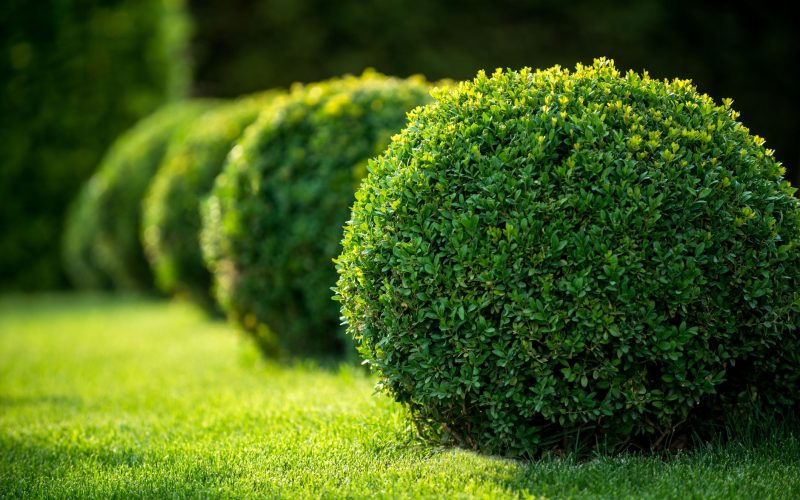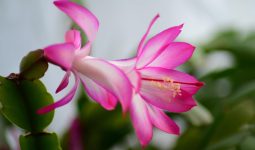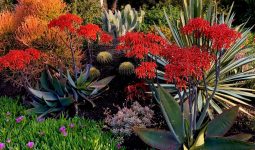There are many different types of shrubs in India, which have many benefits for the home gardener and homeowner.
Shrubs provide privacy and shelter from the sun and add beautiful foliage, flowers, or berries to your garden.
There are many different types of shrubs in India that grow naturally, and their flowers and fruits can be used in cooking, medicine, or decoration.
1. Yellow Rose
Yellow Rose, the first of the types of shrubs in India, is a deciduous plant and grows up to 3 meters (10 feet) tall.
It has yellow flowers and dense, dark green leaves. The flowers are fragrant and attract butterflies, bees, and other pollinating insects.
Also, they are attractive to hummingbirds. Yellow Rose is drought tolerant and thrives on neglect once established. Pruning may be necessary if the plant becomes too large.
However, Yellow Rose prefers full sun but will tolerate shade or partial sun as well, with some leaf scorch during summer months when grown in high temperatures.
2. Mahonia Shrub
Mahonia is a genus of flowering plants in the family Berberidaceae, which are commonly known as Oregon grape.
As the second on the list of the types of shrubs in India, Mahonia spp is used for hedges and as specimens in parks.
One species from this genus is Mahonia aquifolium or Oregon grape. It is an erect evergreen shrub with shiny green leaves arranged in pairs on leaf stalks that grow to about one foot long.
Also, flowers are yellow-green and borne at the ends of branches. They bloom from March to April and have a very pleasant fragrance.
3. Shrubby Cinquefoil
Next on the types of shrubs in India, the Cinquefoil or Shrubby Cinquefoil (genus Potentilla) is a genus of plants belonging to the Rosaceae family. They are perennial, herbaceous plants with semi-woody roots and stems.
Furthermore, the leaves are palmately lobed and divided into five to seven parts. The flowers are borne either singly or in groups at the end of the stem.
Each flower has five petals with an unusual hooked tip. They prefer dry conditions but will grow well in moist soil as well.
4. Yellow Azalea
Yellow Azalea is a shrub with a height and spread of about 3-4 feet. It prefers well-drained soil but will also grow in clay or heavy clay soils. This plant has yellow flowers that bloom from May to July.
They prefer full sun and should be planted at least 10 feet from the house. Fertilize during the flowering season with an acidic fertilizer such as 5-10-10, but do not fertilize while they are dormant. Prune back older branches if they have grown too large for the space allotted.
Remove any suckers that form below ground level by cutting them off just above the root ball. Not too hard to maintain, right? Just like the other types of shrubs in India.
5. Witch Hazel
Though it is on the list of the types of shrubs in India, Witch Hazel is a tree, not a shrub. However, it’s worth mentioning as it has many medicinal and practical uses.
Witch Hazel is used to making an herbal drink called ‘toddy’, which has been shown to reduce the frequency and severity of colds.
Also, it helps reduce fever, headache, indigestion, joint pain, muscle pain, and motion sickness. The leaves are also dried and used to make tea which is thought to be good for the digestive system.
6. Hydrangea
Hydrangea is one of the types of shrubs in India that is popular. They are often planted near houses or used for ornamental purposes.
In addition, Hydrangea shrubs are deciduous and grow to a height between 1 and 2 meters. The leaves are spirally arranged, and the flowers come in all sorts of colors, including blue, purple, pink, red, and white.
7. Oleander
Oleander is a flowering plant in the dogbane family, Apocynaceae. Looking at the list of the different types of shrubs in India, it is most common as a cultivated ornamental plant.
Proceeding, Oleander grows to 2-8 meters tall, with spiky evergreen leaves and clusters of fragrant white flowers. The flowers grow on long stems that rise above the foliage clumps.
8. Hibiscus
Yes! The Hibiscus is a part of the types of shrubs in India. It is a genus of flowering plants in the mallow family, Malvaceae.
It contains around 200 species, most of which are native to the Old World. The best-known species is H. syriacus, commonly known as the hibiscus or rose mallow.
Also, it was originally classified as a member of the genus Althaea when Linnaeus published his work Species Plantarum in 1753.
9. Bougainvillea
The Bougainvillea is a type of flowering plant out of the types of shrubs in India that is popular for its vibrant and colorful flowers.
The flowers are typically red, pink, orange, or purple. It’s also known as the Coral Tree because it produces foliage with a reddish-purple hue.
Moving on, the Bougainvillea is often used as an ornamental plant and grows well in warm climates like India. These plants are perfect for those who want to grow their own plants at home.
Why? Because they require little maintenance and grow quickly. Consequently, if you want to add some color to your garden, consider growing a Bougainvillea plant!
10. Yellow Camellia
The Yellow Camellia is not only it one of the different types of shrubs in India, it is also a beautiful flowering plant found throughout the world. It is very popular around the world because it has such a beautiful color and appearance.
Moreso, the yellow camellia tree produces flowers year-round. This makes it a great choice for people who want to show off their landscaping all year.
The flowers on this tree also have an amazing scent that will make your whole backyard smell as if it’s been doused with perfume.
This plant prefers full sun, and if you give it enough water, its roots will grow deep into the ground. This helps to keep them from being hit by frost in the winter months.
11. Japanese Rose
Like other types of shrubs in India, the Japanese Rose is a perennial flowering shrub. The flowers are often deep pink but can also be white or purple. This plant is popular because it’s hardy and easy to grow.
You will find this bush in the wild during warmer months; when the weather cools, they go dormant. It is a good idea to cut them back before winter arrives, so they don’t become overgrown.
Some unique features about this plant make it perfect for gardens and landscaping. As a plus, the flowers have an incredible fragrance.
Therefore, they are perfect for people who want their own scent to greet guests as they come into the house.
They also produce beautiful hips that attract butterflies, a great way to bring nature into your yard or garden.
12. Butterfly Bush
India has many different types of shrubs, including plants and trees. One type is the Butterfly Bush. The Butterfly Bush is also called the Blackberry Lace Flower.
Proceeding this bush has a dark purple color with white flowers on it. It grows up to three feet tall but can be trimmed to any height you want.
The butterfly bush likes sun and warmth, so it’s best to plant this where it will get the most sunlight possible. You should have moist soil for this plant because it does not like dry soil or hot temperatures.
13. Plumeria
Plumeria is a medium-sized evergreen tree with a dense, rounded crown. Plumeria is commonly known as Frangipani or Plumeria, and its flowers are often found adorning the Hindu temples in south India.
This plant has been used for medicinal purposes for centuries and is thought to bring joy, peace, and prosperity when planted near a house.
The large, showy flower clusters are white to cream-colored with a sweet fragrance that attracts pollinators like bees.
Do you want to fill your home with nice scents but are confused about what to choose from all types of shrubs in India? You can’t go wrong with Plumeria!
14. West Indian Jasmine
The West Indian Jasmine is known for being one of India’s most durable types of shrubs, able to withstand heat, humidity, dryness, and pests.
Also, this plant has medicinal properties that help alleviate nervous tension and have antioxidant properties.
15. Boxwood
Boxwood, often called Buxus sempervirens, is a species of plant in the genus Buxus. It is a slow-growing evergreen plant cultivated as an ornamental plant.
It is one of the most popular plants for hedges, and its leaves have been used as a traditional medicine to treat skin disorders such as warts.
That being said, Boxwoods produce small white flowers followed by small green fruits, which are about 1 cm long.
Boxwoods are very sensitive to frost and will not tolerate temperatures below -5°C or 19°F for any length of time without protection.
They thrive best in conditions where the average temperature ranges from 13°C to 22°C or 55°F to 72°F.
16. Arborvitae
On our list of the types of shrubs in India, we have Arborvitae, an evergreen shrub that provides many benefits.
Arborvitae, also known as the Chinese cedar, is related to cedars from North America. It has a natural pyramidal shape and grows very quickly (up to three feet per year).
For all these reasons, arborvitae is often used for hedges or privacy screens. The plant has an attractive blue-gray color, and it’s drought-tolerant once established.
Arborvitae does have a few drawbacks – notably, its sap is toxic if ingested by humans or animals. This means people must wear gloves when pruning trees or handling cuttings.
17. Devil’s Backbone
The Devil’s Backbone is a type of shrub that has been cultivated for its edible fruit. It grows well in dry or moist soil and requires a lot of suns.
In addition, this plant may grow up to three meters tall in the wild, but it rarely exceeds one meter when grown as a domestic plant.
The flowers are small and white with five petals, while the fruit is egg-shaped, orange, and covered with prickles. And it is also the last on our list of the different types of shrubs in India!
Conclusion
In this blog post, we have discussed different types of shrubs in India that would be ideal for landscaping.
We have also provided information on the geographical location where these plants are found as well as their various uses. We hope you are satisfied with this article!








